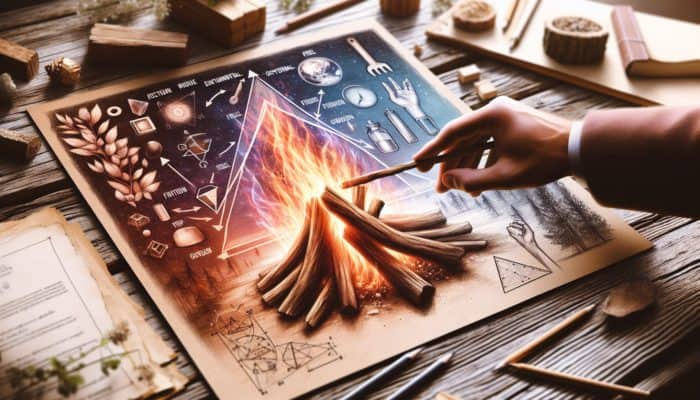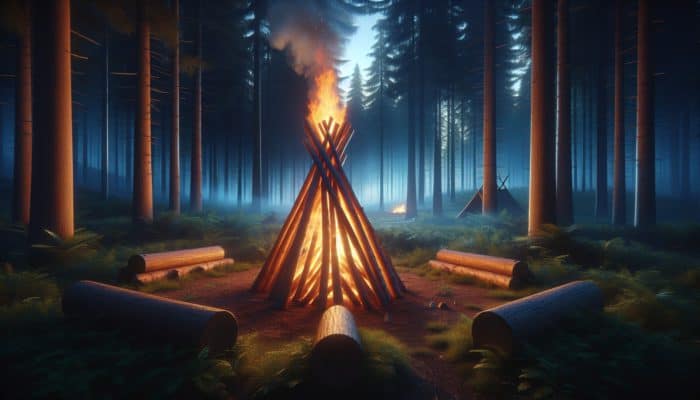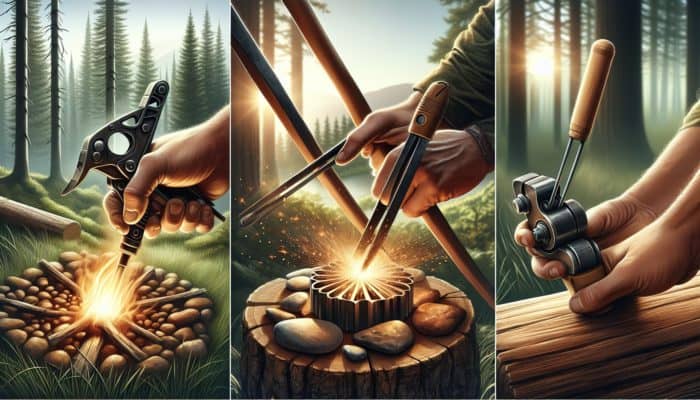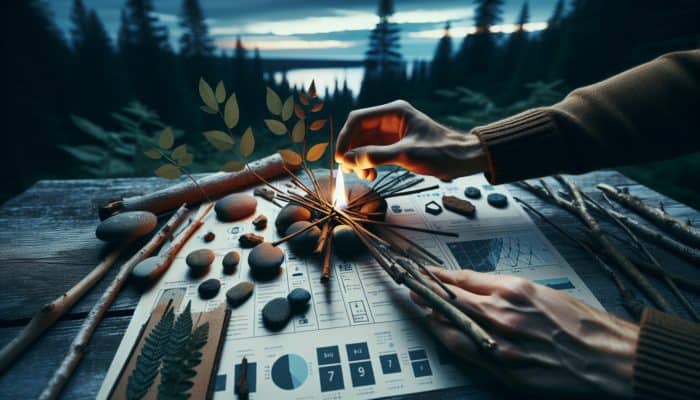Mastering the Fundamental Elements of Fire-starting
Grasping the Essential Fire Triangle for Effective Ignition

Fire-starting Without Matches: Grasping the concept of the fire triangle is crucial for successfully igniting a fire without relying on matches. This triangle comprises three essential elements: heat, fuel, and oxygen. For a fire to ignite and remain burning, all three components must be present in appropriate quantities. For instance, heat can be generated through methods such as friction, sparks, or various chemical reactions; fuel typically involves materials like wood or dry grass, and oxygen is abundant in the atmosphere around us.
Achieving a successful fire involves effectively balancing these three elements. If any component is absent, ignition becomes impossible, or the fire may rapidly extinguish. By understanding the dynamics of this triangle, you can manipulate conditions to foster a consistent and reliable flame. For example, during strong winds, you may need to adjust the fuel quantity or employ barriers to prevent excessive oxygen loss, ensuring your fire remains lit and manageable.
Collecting the Essential Materials for Fire-starting
Gathering the right materials is fundamental for starting a fire without matches. Various materials serve specific roles in the fire-building process, and recognizing which to utilize can significantly enhance your chances of success. Here’s a list of key materials that are effective in starting a fire:
- Tinder: Small, dry items such as dry leaves, bark, or cotton balls.
- Kindling: Small twigs or sticks that ignite easily.
- Fuel: Larger logs that sustain the fire over time.
- Firestarter materials Include Natural items like pine resin and processed options such as waxed paper.
- Ignition tools: Items such as flint and steel or a magnifying glass.
- Fireboard and spindle: Essential for friction-based techniques such as the bow drill.
- Containers: To hold tinder or other materials while you set up your fire.
- Windbreak materials: Rocks or logs to protect the fire from strong winds.
Each material plays a unique role in the fire-starting process. Tinder is vital as it catches the initial spark; kindling helps to ignite larger fuel sources, while fuel ensures the fire continues burning. It is crucial to ensure that all materials are dry, as this significantly increases the likelihood of successful ignition.
Strategically Preparing the Fire Site for Safety and Success
Preparing the fire site correctly is essential for ensuring both safety and efficiency. Selecting an appropriate location can dramatically enhance your chances of successfully starting a fire without matches. Begin by identifying a flat, open area that is clear of overhanging branches, dry brush, or any other flammable materials. Carefully clear away debris such as leaves or twigs to create a clean space for fire construction.
Once the area is cleared, create a fire bed by digging a shallow pit to contain the flames. Surround the pit with rocks if possible, as this will help insulate the heat and prevent the fire from spreading uncontrollably. Additionally, please consider the direction of the wind; positioning your fire so that the wind blows towards it can help facilitate oxygen flow, promoting a more robust flame.
Always adhere to local regulations regarding fire safety, particularly in wilderness areas. Certain regions may impose restrictions during drought periods or periods of high wildfire risk. By thoughtfully preparing your fire site, you lay the groundwork for a successful and safe fire-starting experience.
Constructing and Maintaining a Steady Fire

Building a fire is both an art and a science, and utilising the right structure is vital for ensuring it burns steadily. One of the most effective configurations is the teepee formation, where kindling is arranged in a cone shape around a small pile of tinder. This structure allows for optimal airflow, ensuring that flames can quickly reach the kindling. Alternatively, the log cabin arrangement involves stacking logs in a square, which can create a stable and long-lasting fire.
To maintain a consistent burn, continually monitor the fire's condition and make adjustments as needed. If you observe flickering flames or a struggling fire, adding more kindling or rearranging the logs to improve airflow may be beneficial. Additionally, be mindful of environmental factors; in strong winds, you may need to shield the flames with rocks or logs to prevent them from being extinguished.
It is essential to note that environmental conditions can significantly impact the behavior of your fire. For instance, in damp conditions, it may take longer for the fire to catch. In such situations, employing firestarter materials can markedly enhance your chances of success. Ultimately, mastering the construction and sustainability of a fire without matches demands patience, careful observation, and consistent practice.
Insights from Experts on Fire-starting Without Matches
Proven Techniques from Seasoned Outdoorsmen
Seasoned outdoorspeople offer invaluable insights when it comes to starting a fire without matches. Numerous techniques have been refined over time based on real-world applications and experiences in diverse environments. Here are some expert-recommended fire-starting methods:
- Bow Drill: A traditional friction-based technique requiring a spindle and fireboard.
- Hand Drill: Generates friction by spinning a spindle between hands against a fireboard.
- Flint and Steel: Utilises sparks created by striking steel to ignite tinder.
- Fire Plow: Scraping a stick against a groove can generate enough heat to ignite tinder.
- Solar Ignition: Focuses sunlight onto tinder using a lens or polished surface.
- Fire Syringe: A tool that creates pressure to heat air and ignite tinder.
- Fire Piston: Compresses air inside a cylinder to ignite tinder through rapid heating.
- Char Cloth: A material that smoulders when sparked, aiding in ignition.
Each technique possesses unique advantages and can be effective under different circumstances. For instance, the bow drill may be optimal in dry environments, while flint and steel can be particularly valuable in wetter conditions where other methods may falter. By learning and practising these diverse methods, you increase your adaptability in the wild, ensuring you always have a reliable means to start a fire.
What Are the Most Reliable Methods for Igniting a Fire?

When it comes to reliability in fire-starting without matches, certain methods consistently demonstrate effectiveness across a variety of conditions. The most dependable methods include the bow drill, flint and steel, and hand drill techniques. These methods are preferred by many outdoor enthusiasts owing to their accessibility and efficiency.
The bow drill is widely recognised as one of the most effective methods due to its capacity to generate the necessary heat through friction. It requires minimal materials, often found in nature. The flint and steel method is also highly reliable, producing sparks that can readily ignite tinder, even in damp conditions. Meanwhile, the hand drill method, while more challenging, is a valuable skill to master, especially when using the appropriate materials and techniques.
Understanding the reliability of these methods can significantly impact your success, particularly in survival scenarios. Regular practice in varied environments will enhance your proficiency, preparing you for any outdoor adventure.
How Can You Enhance Your Fire-starting Skills?
Enhancing your fire-starting skills without matches necessitates a combination of practice, knowledge, and adaptability. Start by familiarising yourself with various techniques and materials that are most effective in your local environment. Practice frequently under different conditions, whether humid, dry, or windy, to build confidence.
Participating in survival courses or outdoor workshops can provide invaluable hands-on experience. These programmes often feature expert instruction, helping to refine your techniques and introduce you to new methods you may not have previously considered. Additionally, documenting your fire-starting attempts will enable you to analyse both your successes and failures, furthering your understanding.
Being aware of environmental factors is equally crucial. For example, understanding how moisture levels affect your materials can help you select the best tinder and fuel. Practising in various locations, such as forests, coastal regions, or even urban settings, will prepare you for a wide variety of scenarios, thereby enhancing your overall fire-starting skills.
Friction-Based Techniques for Fire-starting Mastery
Understanding the Bow Drill Technique for Effective Fire Creation
The bow drill technique is one of the most recognised and effective methods for igniting a fire through friction. This technique requires several essential components: a spindle, bow, and fireboard. The spindle is a straight stick that rotates against the fireboard when tensioned by the bow, generating the necessary heat through friction to ignite tinder effectively.
To set up the bow drill, begin by crafting a bow from a flexible branch. Attach a cord or string tightly between the ends of the bow. Next, select a straight spindle and a fireboard made from softer wood, ensuring both are thoroughly dry. Place the spindle in a small notch on the fireboard, securing the base while you use the bow to rotate the spindle quickly.
As you create friction, small shavings will accumulate in the notch. Once the shavings begin to smoke, carefully transfer them to your tinder bundle and blow gently to ignite the tinder. This technique, while effective, requires practice to master the right tension and speed for optimal results, making it a rewarding skill for any outdoor enthusiast.
Executing the Hand Drill Method for Fire Generation
The hand drill method is one of the simplest and oldest fire-starting techniques, relying on the friction produced between a spindle and a fireboard. Unlike the bow drill, this method requires no tools beyond your hands, making it an incredibly versatile option for fire-starting, especially in survival scenarios.
To execute the hand drill, select a suitable spindle and fireboard made from soft, dry materials. The spindle should be approximately the thickness of your pinky finger and around two feet long. Place one end of the spindle in a notch on the fireboard, applying downward pressure while rotating the spindle between your palms. The friction generated will create heat and eventually produce fine dust.
As you continue to rotate, look for smoke and a small ember to form. Once you have an ember, gently transfer it to your tinder bundle and blow gently to ignite it. The hand drill method requires significant practice and physical endurance but can be incredibly rewarding, especially when successfully executed under challenging conditions.
What Challenges Do Friction Methods Present?
Friction-based fire-starting methods can present several challenges, often arising from the physical demands and environmental conditions required for success. One major challenge is the time commitment; generating sufficient heat through friction can take considerable effort, particularly for beginners. It requires both technique and persistence, which can be discouraging in survival situations.
Another significant challenge is the necessity for specific materials. Both the spindle and fireboard must be composed of the appropriate type of wood—softer woods, such as cedar or willow, are optimal for generating friction. If you find yourself in a damp environment, sourcing the right materials that are dry enough can be particularly arduous. Additionally, these methods are often sensitive to environmental conditions; wind can dissipate the heat generated, while moisture in the air can impede ignition.
Despite these challenges, mastering friction methods is immensely rewarding. Understanding these limitations enables you to adapt your techniques and materials, thereby improving your chances of success under varying conditions and equipping you with invaluable skills for outdoor survival.
Research-Backed Advantages of Fire-starting Without Matches
Enhancing Your Survival Skills Through Fire Mastery
Acquiring the ability to start a fire without matches significantly enhances your survival skills, equipping you with essential tools for emergencies. Fire serves a pivotal role in survival, providing warmth, enabling food preparation, and serving as a signal for rescue. When you master the ability to ignite a fire without conventional means, you cultivate a sense of independence and resilience.
In emergencies, the capability to start a fire can be life-saving. For example, if you find yourself lost in a wilderness area, knowing how to create warmth can help protect you from hypothermia. Similarly, a fire allows you to purify water by boiling it, ensuring it is safe for consumption. To enhance your survival skills, incorporate fire-starting techniques into your outdoor training regimen. Experiment with various methods, materials, and conditions to build confidence and expertise.
Furthermore, understanding fire safety and the environmental implications of making a fire prepares you to handle potential hazards responsibly. Mastering the art of fire-starting without matches fosters a mindset of self-sufficiency and resourcefulness—critical attributes for anyone venturing into the wild.
Boosting Confidence in Outdoor Scenarios
Mastering the skill of starting a fire without matches greatly enhances your confidence in outdoor settings. Knowing you can generate warmth, cook food, and signal for assistance fosters a sense of empowerment and control over your surroundings. This newfound confidence transforms your outdoor experiences, encouraging you to explore more challenging terrains and scenarios.
One of the most significant aspects of building confidence is consistent practice. Engage in regular fire-starting exercises, experimenting with diverse techniques and materials. Each successful fire instils a deeper trust in your capabilities, preparing you for potential survival situations. Moreover, sharing your skills with others reinforces your knowledge and helps cultivate a supportive community passionate about outdoor skills.
A confident mindset also leads to more enjoyable experiences. Instead of feeling apprehensive about the outdoors, you will approach adventures with excitement, knowing you possess the necessary skills to navigate challenges. This confidence not only enhances your personal growth but also deepens your appreciation for nature and the art of outdoor living.
What Psychological Benefits Come from Mastering Fire-starting Techniques?
The psychological benefits of mastering fire-starting without matches extend beyond mere survival skills. Developing this capability nurtures a sense of self-reliance, resilience, and mental fortitude. Knowing you can start a fire when needed can significantly alleviate anxiety in outdoor settings, thereby allowing for a more enjoyable overall experience.
The act of fire-starting itself can be quite meditative. The focus required to gather materials, learn techniques, and execute the process encourages mindfulness and fosters a connection to the natural world. This engagement can lead to reduced stress levels and enhanced mental clarity, as you immerse yourself in the practice of fire-making.
Moreover, achieving the skill of fire-starting without matches can bolster your overall self-esteem. Overcoming the challenges associated with this practice reinforces your ability to face adversity and build problem-solving skills. Whether preparing for a camping trip or navigating an unexpected situation in the wilderness, mastering fire-starting techniques offers significant psychological benefits, contributing to a well-rounded outdoor experience.
Exploring Alternative Fire-starting Techniques
Implementing the Fire Plow Technique for Efficient Ignition
The fire plow is a straightforward yet effective method for initiating fires using friction. This technique involves using a stick to scrape against a groove in a fireboard, generating heat through friction. The fire plow method requires minimal materials, making it a practical option when other resources are scarce.
To execute the fire plow, select a sturdy stick and a softer fireboard. The fireboard should have a groove carved into its surface, approximately an inch deep. Begin by applying pressure to the stick while rapidly sliding it back and forth across the groove. The friction generated will create fine shavings that can eventually ignite when enough heat is produced.
Once you have gathered sufficient material, transfer the embers to your tinder bundle. As with other friction methods, this technique requires practice and persistence. The fire plow can serve as an effective backup option, particularly in environments where traditional materials for bow drills or hand drills may be limited.
Utilising the Flint and Steel Method for Spark Generation
The flint and steel method is a tried-and-true fire-starting technique that produces sparks to ignite tinder. This method involves striking a piece of flint against a steel surface to create sparks, which can then be directed towards your tinder bundle. It serves as an effective alternative when conventional methods are not feasible.
To use this method, gather a high-carbon steel striker and a piece of flint. Create a small nest of tinder within easy reach, ensuring it is dry and finely shredded. Strike the flint with the steel to generate sparks aimed directly at the tinder. Timing and technique are crucial; aim to strike in a manner that produces a shower of sparks rather than a mere glancing blow.
Once the tinder ignites, gently blow on it to encourage the flames to grow. The flint and steel method is particularly valuable in damp conditions where traditional friction methods may struggle. Mastering this technique adds another reliable tool to your fire-starting arsenal.
How Can Solar Energy Be Harnessed for Fire-starting?
Harnessing solar energy for fire-starting is an innovative and sustainable approach that relies on focusing sunlight onto tinder to generate heat. This method requires clear skies and a means to concentrate sunlight, typically achieved through a magnifying glass or other lenses.
To begin, gather dry tinder and arrange it in a small nest. Position the magnifying glass above the tinder, directing sunlight through the lens to create a concentrated beam of light. The focus of the sunlight generates enough heat to ignite the tinder. Achieving the desired results may require time and precise positioning, so patience is crucial.
This technique is particularly effective on sunny days and offers a unique way to harness natural resources. However, it can be less reliable in overcast conditions, making it essential to have backup fire-starting methods ready. Mastering solar fire-starting techniques broadens your skillset and showcases the diverse methods available for creating fire without matches.
Revisiting the Bow Drill Technique for Fire-starting Proficiency
The bow drill technique is a highly efficient method for igniting fires that utilises the friction generated by a bow to spin a spindle against a fireboard. This technique is well-suited for those who have practised and can obtain the necessary materials.
To set up the bow drill, select a flexible branch for the bow and a dry, softwood fireboard. The spindle should be straight and adequately long, typically around two feet. The bow is strung tightly, and the spindle is placed in a notch on the fireboard. As you pull the bow back and forth, the spindle rotates, generating friction and heat against the fireboard.
Once you observe smoke and potentially an ember forming, carefully transfer it to your tinder bundle and blow gently to ignite it. The bow drill method requires practice to master the right tension and speed, but it remains one of the most effective friction-based techniques for fire-starting.
Safety and Environmental Considerations for Fire-starting
Prioritising Fire Safety in All Situations
Prioritising fire safety is imperative to prevent accidents and protect the environment when starting fires without matches. Understanding the risks associated with fire-making is essential for ensuring a safe experience. Always check local regulations regarding open fires, as certain areas may impose restrictions due to fire hazards.
When constructing a fire, select a site that is clear of flammable materials and debris. Construct a fire ring using rocks, and ensure there is a safe distance between the flames and any nearby objects that could be flammable. Regularly monitor the fire's size and behaviour, particularly in windy conditions that could lead to an uncontrolled blaze.
Never leave a fire unattended and always have a means to extinguish it promptly. Water, dirt, or sand can be used effectively to extinguish any flames. Ensuring fire safety not only protects you but also preserves the surrounding environment for future generations to use and enjoy.
Strategies for Minimising Environmental Impact
Minimising the environmental impact of fire-starting without matches is a principle that every outdoor enthusiast should uphold. Adopting responsible fire-starting practices helps conserve the natural environment and ensures that future generations can continue to enjoy the great outdoors.
One of the most effective ways to minimize your impact is to follow the Leave No Trace principles. Choose established fire rings when available and avoid creating new fire scars in pristine areas. Use only downed and dead wood for fuel, leaving living trees undisturbed for future growth and ecological balance.
Additionally, make sure that all materials are gathered responsibly, without damaging vegetation or disrupting habitats. When it’s time to extinguish the fire, ensure it is completely out and cool to the touch before leaving the site. Being conscientious about your fire-starting practices helps contribute to the sustainability of outdoor spaces for everyone.
What Are the Best Practices for Safely Extinguishing Fires?
Following best practices for safely and effectively extinguishing fires is crucial for both safety and environmental protection. The first step is to ensure that the fire is completely out before leaving the site. Pouring water over the fire is an effective method; use enough water to saturate the ashes and eliminate any remaining heat.
Stir the ashes with a stick or shovel to ensure all embers are extinguished. If water is not available, use dirt or sand, but be thorough in covering the fire and mixing it in with the ashes. Always check for lingering heat by feeling the area with your hand or foot before departing.
Remember, leaving a fire smouldering poses a fire hazard that could lead to wildfires. By adhering to these best practices for extinguishing fires, you fulfil your responsibility as a steward of the environment and ensure a safe outdoor experience for yourself and others.
Frequently Asked Questions About Fire-starting
What materials can I use for tinder?
Tinder can encompass dry leaves, grass, bark, cotton balls, and even finely shredded paper. The key is to utilise materials that ignite easily and burn quickly, making them effective for starting a fire.
How do I determine if my firewood is dry enough?
Dry wood emits a hollow sound when struck together and has a lighter colour. It also tends to break easily. If the wood feels heavy or damp, it likely contains moisture and may not be suitable for burning.
Can I start a fire in the rain?
Yes, it is possible to ignite a fire in the rain, but you'll need to gather dry materials from sheltered areas, such as under trees, and utilise effective methods like fire starters or flint and steel.
Is it safer to start a fire in a fire pit?
Yes, using a fire pit is substantially safer as it contains the fire and reduces the risk of flames spreading. Always ensure the fire pit is clear of debris to maintain safety.
What should I do if my fire won't start?
If your fire fails to ignite, check the dryness of your tinder and kindling. Ensure adequate airflow and consider adjusting the arrangement of your materials to encourage burning.
How can I develop my fire-starting skills?
Regular practice in various conditions, learning multiple methods, and experimenting with different materials will enhance your fire-starting skills and build your confidence.
What precautions should I take when building a fire?
Clear the area of flammable materials, utilise established fire rings, and keep water or dirt nearby for extinguishing the fire. Never leave a fire unattended to prevent accidents.
Can I use household items as fire starters?
Yes, items such as cotton balls soaked in petroleum jelly, dryer lint, and wax paper can serve as excellent fire starters, significantly improving your chances of igniting a flame quickly.
What is the best wood for starting a fire?
Softwoods, such as pine, cedar, and spruce, are excellent for kindling due to their high resin content, which facilitates quick ignition. For fuel, hardwoods like oak and hickory burn longer and hotter, providing sustained heat.
What should I do if I see smoke but no flame?
If you observe smoke without a flame, gently blow on your tinder bundle to provide oxygen and encourage a flame to ignite. If it still does not catch, check the materials for dryness and make necessary adjustments.
Explore our world on X!
Survival Tent Options: Your Ultimate Guide
Explore the Different Types of Survival Tents for Your Adventures Discover the Benefits of Dome Tents for Outdoor Enthusiasts Survival Tent Options: Dome tents have gained immense popularity among outdoor enthusiasts, primarily for their outstanding stability and spacious interiors. Featuring a unique curved structure, these tents offer exceptional wind resistance and significant internal volume, making […]
Shtf Fire-Starting: Essential Techniques and Tools
Mastering the Fundamental Concepts of SHTF Fire-Starting Comprehending the Essential Fire Triangle Shtf Fire-Starting: The fire triangle is a fundamental concept that anyone serious about SHTF fire-starting must understand. This triangle comprises three vital elements: heat, fuel, and oxygen. Mastering these components is essential for successful fire-starting in any scenario. Without heat, you cannot ignite […]
Surviving Without Fuel: Essential Strategies
Exploring the Fundamentals of Fuel-Free Living What Is the Concept of Living Without Fuel? Surviving Without Fuel: The concept of living without fuel centers on the pivotal goal of significantly reducing or entirely eliminating our dependence on conventional energy sources, such as gasoline and diesel. This lifestyle choice underscores the importance of adopting sustainable alternatives […]
Grid-Down Survival: Essential Strategies for Resilience
Effective Strategies for Preparing for Grid-Down Scenarios Building a Comprehensive Stockpile of Essential Supplies Grid-Down Survival: To thrive during a grid-down scenario, building a comprehensive stockpile of essential supplies is crucial for your survival and that of your family during prolonged power outages. The strategy involves gathering a diverse assortment of items that meet fundamental needs such […]








This post really resonates with me, especially the emphasis on understanding the fire triangle. It brings to mind my own experiences camping in the wilderness, where I’ve had to rely on natural methods to start fires without matches. I remember one evening trying to create a spark using the bow drill method—it was challenging, but when I finally achieved that first ember, it drove home the importance of balancing heat, fuel, and oxygen.